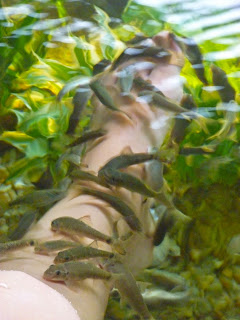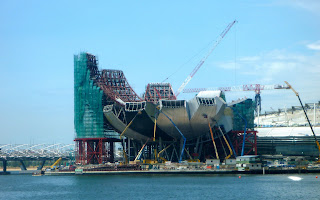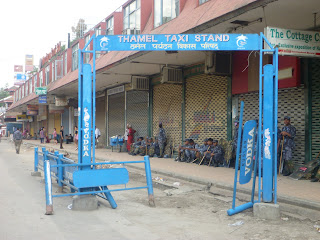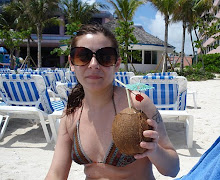



Singapore
May 5-7
I had strategically planned to stop in Singapore after spending a good chunk of time in India and Nepal, both amazing countries yet neither exactly noted for their cleanliness or hygiene. Singapore has been labeled by some as sterile, stuffy, bland, spotless. It’s rumored that you can get a fine for chewing gum or spitting on the street. After squatting in the most fetid toilets one could ever imagine (think Trainspotting, but 100 times worse), that was just fine with me. It’s exactly what I wanted.
I had scored a window seat on the plane and arrived at night. The first thing I noticed was that the ships anchored in the harbor were actually arranged in neat little rows. There were no haphazard floating vessels that one is used to seeing. Rather, it was more like flying over Port Newark, with all the cars and trailers parked in their assigned spots. I felt the need to brush the Kathmandu dust off my pants and make myself presentable just to set foot into the airport.
And, my, what an airport. Changi International Airport is not just an airport, of course. It’s an actual destination, with its own tourist brochures and guides. If you have longer than a two hour layover, the airport will give you a free tour of the city. Need a shower? No problem. Those are located in the orange wing. Tired? There’s a nap center with actual beds. Traveling with a family of young children? Well, just follow the signs to the family rooms, where you can sit down on the comfort of plush couches, pop in a Disney DVD and rest up until your connecting flight is ready to board. Terminal 1 has a Bali-inspired swimming pool.
We deplaned and were greeted by a fleet of airport staff telling us in the most perfect English where immigration was, how long the wait was, and how many windows were open to foreigners. The wait was less than five minutes. At the counter sat several bowls of candy to choose from, labeled “Thank you for visiting Singapore. Changi International Welcomes You.” The immigration official expressed his disappointment that I would only be staying in his fine country for a few days, and urged me to stay longer if at all possible. I made my way to the baggage carousel and waited. For the first time in my entire trip, my pack didn’t surface. Before I had a chance to look around for the lost luggage room, a Changi employee was already at my side and on the case. A red light started flashing, an alarm started to sound, and an army of people flocked my way. That kind of alarm at JFK means you’d better drop to your knees and put your hands above your head, because the drug sniffing dogs are coming to tear you apart. In Singapore, it was a disgrace to mishandle my filthy backpack. Walkie talkies were fervently used, and I was assured and reassured that my baggage would be found no matter what. I was cool, though a little nervous that if the bag had not made it out of the KTM airport, I’d never see it again. Less than 3 minutes later, a sweaty, frazzled man literally rode through the flaps of the baggage carousel on his knees, clutching my luggage for dear life. He presented it to me with the utmost apologies for the (10 minute) delay, and was then subsequently chewed out by his supervisor in a language I couldn’t understand. I heard the word “embarrassment” uttered a few times, told them that really, it was no big deal, thanked them profusely, and made my way to the taxi line. It was a fine welcome to the country.
Though centrally located, my guest house was slightly difficult to find, and the taxi driver actually knocked money off the fare for the extra 10 minutes we spent driving around in circles. The accommodation had been recommended to me by a few bands I know who’ve played Singapore, as well as got high marks on Tripadvisor. At 60 bucks/night (more than double what I’d paid for any rooms that were not luxury hotels), I was looking forward to a glorified guest house. It was pretty spartan -- there was no window which is always a downer - and smelled horribly of mildew. The lofty down comforter, plush mattress and neverending piping hot water in the spotless shower made up for the fact that they did not have any other private rooms available. So did the laundry room and the great breakfast buffet. I slept like a rock, but woke up feeling like hell. Guess my body doesn’t like mildew, or toxic black mold, or whatever was growing in there because for the third time on this trip, I was sick with some kind of nasty cold. No problem, though. This being Singapore, the land of exquisite and serious street food, I set out for something spicy to clear my sinuses.
I’d already had breakfast, but that wasn’t going to stop me from sampling as much food as possible from this culinary wonderland. As one orders cacio e pepe as a first meal in Rome, one must immediately eat the national dish, chicken rice, in Singapore. I asked the desk staff where the nearest place was. They laughed at me. “Chicken rice on every corner in Singapore...try this place down the road, and also this place and that place and...” Armed with four chicken rice joints in a 3 block radius, I made my way to the nearest one, an open-air stall on the corner. Chicken rice is basically chicken poached in broth served over rice that is also cooked in the broth. It’s accompanied by condiments -- some sort of sticky soy sauce, hot sauce, hot peppers. Sounds simple, and maybe the preparation is, but the resulting dish is far from. The flavors are complex and deep - still a spice mix I can’t put my finger on - and everyone has a different way to eat it. Singaporeans are extremely serious about their food and they are not shy about telling you so. One person told me to drink the broth first. Another told me only to add soy to the chicken, but to eat the rice separately. Someone else offered a way to mix everything together, but save the (not crispy) skin for last. It didn’t really matter how I ate it, though. It would have been delicious in any one of their recommended combinations.
In addition to being military clean and orderly, Singapore is famous for something else: its shopping malls. In fact, there is an entire boulevard spanning several miles that is all shopping malls, one next to the other, multi-leveled behemoths dedicated to taking your money. Following a mild temptation to throw in the towel in Kuala Lumpur and blow the rest of my budget on a Vuitton bag, I had not been anywhere close to luxury shopping. It was not what I was interested in experiencing on this trip, but seeing as I’d be heading to Bali in a few days, I hit the mall strip in search of a new bathing suit. After perusing a few stores and realizing quickly that I would end up a medical tourist in search of cheap lyposuction if I continued looking here (every salesperson was handing me extra large bathing suits and exclaiming how I was a fat American. Asians are decidedly built a little more svelte than me.) I decided to stick with my ratty American-size medium bikini and head to the food court.
In America, the thought of eating at a mall food court is not exactly appetizing or glamorous. They are mostly loaded with unhealthy fast food chains, greasy cheeseburgers or 3000 calorie burritos. “Fast food” does not have good connotations. In Asia, especially in Singapore, food courts are called hawker centers and they are where the locals take their meals. And they could not be farther in selection, quality, and pride from their US counterparts. In the hawker center I visited, I stopped counting after about 20 different stalls, offering everything from Indian curries with fresh made naan to noodle stalls to dumpling carts to sushi, and of course the ubiquitous chicken rice. One stall in particular caught my eye...made to order hand cut noodles with your choice of meat, prepared how you wanted them. It was a sight to see the man rolling out the dough and using something akin to a rustic string instrument to cut the noodles with flawless precision - in a stall no bigger than a hot dog cart. Next to him was the meat man, who has probably cooked nothing but meat his whole life, cutting up perfectly lacquered poultry with the biggest cleaver I’ve ever seen at break-neck speed. As I was still feeling sickly, I opted for the duck noodle soup. I was presented with a heaping bowl of steaming, dark broth piled high with noodles, draped with an entire fanned out duck breast. The noodles were among the best I’ve ever had: fresh, chewy, toothsome. They stood up to the strong broth (and subsequent hot sauce I doused them with) with their own delicate eggy flavor, and the duck, a perfect medium rare, was expertly infused with just the right amount of ginger and coriander. It was a dish that sang in harmony, something you’d pay upwards of $25 dollars for in New York. I paid a whopping $3, and slurped it down in a shopping mall.
Feeling much better, I did some sightseeing. Walked down to the water, checked out the famed Raffles hotel, and found myself standing under the Singapore Flyer, a giant ferris wheel that mirrors the London Eye. I hate ferris wheels, but was of course sucked into the shopping mall surrounding the entrance. I was not yet hungry, but certainly took a spin through the food stalls and stores. A foot massage place appeared in between two ice cream stands, and I thought that would be a nice way to kill an hour and catch some much needed air conditioning relief.
It was called the Fish Foot Spa. When I walked in, following the initial welcome blast of high octane air conditioning, I was hit with an unpleasant feety odor. This being Asia, though, it was impossible to leave. Once the proprietor of the spa locked eyes with me, escape became a fantasy. At first I thought I was in a waiting room with koi fish ponds. I quickly realized this was not the case. Sitting around the pools were a few people, pants rolled up, feet soaking in the water. I was overcome with a momentary bought of nausea. It turns out the next thing on the menu would be, well...ME.
I had read about fish spas. I’d even seen a documentary on one based in Turkey. I thought they were things confined to central Asia, but I guess it’s a new rage throughout the continent. Basically, pools of water are stocked with Doctor Fish (small fish a few inches in length). They have an appetite for dead human flesh. You dip your feet into the pool and the fish go to town, feasting on the dead skin on your feet and legs. I wasn’t too keen on the idea. The “being eaten alive” factor wasn’t exactly the relaxing foot massage I was looking for, but I did not have much of a choice. So it was off with the flip flops and into the feeding frenzy. And frenzy it was. These seemingly docile doctor fish hang around spread out at the bottom of the pool, looking relatively harmless. Once their lunch plunges into the water, they all rush for the flesh, giant sharp teeth exposed, some fighting each other off to get a prime bite. I must have had 60 fish dining on my tasty toes. I’m ticklish by nature and had to gnaw on the back of my hand for the first two or three minutes just to be able to stand it. It was a strange sensation, not exactly pleasant, but not intolerable. About halfway into my 30 minute eaten-alive session, I was told by the spamaster that it was time to relocate. Not sure what that meant, I got up and was led to another pool, this one with MUCH BIGGER FISH. These suckers were 6-7 inches in length and fat as sardines. And suck, bite, claw they did. They looked like mini moray eels and they hurt. I reasoned that I was providing an especially hearty meal due to walking around India in flip flops then trekking in the Himalayas, and my feet must have had an inch of dead skin on them. And I have to say, when all was said and done, I’d never had a better pedicure. The result were a pair of soft and supple feet, albeit bleeding and a little raw in some spots.
Back out in the midday heat, it was most definitely time for a snack. I found a gelato stand and ordered a large hazelnut, hoping the fat would settle in the places south of my ankles.









